Modulation Bandwidth Enhancement of Monolithically Integrated Mutually Coupled Distributed Feedback Laser
Abstract
:1. Introduction
2. Numerical Simulation and Device Design
2.1. Numerical Simulation
2.2. Device Structure and Fabrication
3. Experimental Results and Discussion
3.1. Small-Signal Modulation Response
3.2. Large-Signal Modulation Performance
4. Conclusions
Author Contributions
Funding
Conflicts of Interest
References
- IEEE Standard 802.3bs. Available online: https://standards.ieee.org/standard/802_3bs-2017.html (accessed on 10 October 2019).
- 100G Lambda MSA. Available online: http://100glambda.com/specifications (accessed on 10 October 2019).
- Matsui, Y.; Murai, H.; Arahira, S.; Kutsuzawa, S.; Ogawa, Y. 30-GHz bandwidth 1.55-μm strain-compensated InGaAlAs-InGaAsP MQW laser. IEEE Photon. Technol. Lett. 1997, 9, 25–27. [Google Scholar] [CrossRef]
- Kobayashi, W.; Ito, T.; Yamanaka, T.; Fujisawa, T.; Shibata, Y.; Kurosaki, T.; Kohtoku, M.; Tadokoro, T.; Sanjoh, H. 50-Gb/s Direct Modulation of a 1.3-μm InGaAlAs-Based DFB Laser With a Ridge Waveguide Structure. IEEE J. Sel. Top. Quantum Electron. 2013, 19, 1500908. [Google Scholar] [CrossRef]
- Sasada, N.; Nakajima, T.; Sekino, Y.; Nakanishi, A.; Mukaikubo, M.; Ebisu, M.; Mitaki, M.; Hayakawa, S.; Naoe, K. Wide-temperature-range (25°C to 80°C) 53-Gbaud PAM4 (106-Gb/s) Operation of 1.3-μm Directly Modulated DFB Lasers for 10-km Transmission. J. Lightwave Technol. 2019, 37, 1686–1689. [Google Scholar] [CrossRef]
- Selmic, S.R.; Tso-Min, C.; Jiehping, S.; Kirk, J.B.; Mantle, A.; Butler, J.K.; Bour, D.; Evans, G.A. Design and characterization of 1.3-μm AlGaInAs-InP multiple-quantum-well lasers. IEEE J. Sel. Top. Quantum Electron. 2001, 7, 340–349. [Google Scholar] [CrossRef]
- Chen, R.-Y.; Chen, Y.-J.; Chen, C.-L.; Wei, C.-C.; Lin, W.; Chiu, Y.-J. High-Power Long-Waveguide 1300-nm Directly Modulated DFB Laser for 45-Gb/s NRZ and 50-Gb/s PAM4. IEEE Photon. Technol. Lett. 2018, 30, 2091–2094. [Google Scholar] [CrossRef]
- Reithmaier, J.P.; Kaiser, W.; Bach, L.; Forchel, A.; Feies, V.; Gioannini, M.; Montrosset, I.; Berg, T.W.; Tromborg, B. Modulation speed enhancement by coupling to higher order resonances: A road towards 40 GHz bandwidth lasers on InP. In Proceedings of the International Conference on Indium Phosphide and Related Materials, Glasgow, Scotland, UK, 8–12 May 2005; pp. 118–123. [Google Scholar]
- Kreissl, J.; Vercesi, V.; Troppenz, U.; Gaertner, T.; Wenisch, W.; Schell, M. Up to 40-Gb/s directly modulated laser operating at low driving current: Buried-heterostructure passive feedback laser (BH-PFL). IEEE Photon. Technol. Lett. 2012, 24, 362–364. [Google Scholar] [CrossRef]
- Matsui, Y.; Schatz, R.; Pham, T.; Ling, W.A.; Carey, G.; Daghighian, H.M.; Adams, D.; Sudo, T.; Roxlo, C. 55 GHz Bandwidth Distributed Reflector Laser. J. Lightwave Technol. 2017, 35, 397–403. [Google Scholar] [CrossRef]
- Lau, E.K.; Zhao, X.; Sung, H.-K.; Parekh, D.; Chang-Hasnain, C.; Wu, M.C. Strong optical injection-locked semiconductor lasers demonstrating > 100-GHz resonance frequencies and 80-GHz intrinsic bandwidths. Opt. Express 2008, 16, 6609–6618. [Google Scholar] [CrossRef]
- Zhao, X.; Chang-Hasnain, C.J. A New Amplifier Model for Resonance Enhancement of Optically Injection-Locked Lasers. IEEE Photon. Technol. Lett. 2008, 20, 395–397. [Google Scholar] [CrossRef]
- Lau, E.K.; Liang, J.W.; Wu, M.C. Enhanced Modulation Characteristics of Optical Injection-Locked Lasers: A Tutorial. IEEE J. Sel. Top. Quantum Electron. 2009, 15, 618–633. [Google Scholar] [CrossRef]
- Lau, E.K.; Sung, H.-K.; Wu, M.C. Frequency Response Enhancement of Optical Injection-Locked Lasers. IEEE J. Quantum Electron. 2008, 44, 90–99. [Google Scholar] [CrossRef] [Green Version]
- Murakami, A.; Kawashima, K.; Atsuki, K. Cavity resonance shift and bandwidth enhancement in semiconductor lasers with strong light injection. IEEE J. Quantum Electron. 2003, 39, 1196–1204. [Google Scholar] [CrossRef]
- Wang, J.; Haldar, M.K.; Li, L.; Mendis, F.V.C. Enhancement of modulation bandwidth of laser diodes by injection locking. IEEE Photon. Technol. Lett. 1996, 8, 34–36. [Google Scholar] [CrossRef]
- Simpson, T.B.; Liu, J.M.; Gavrielides, A. Bandwidth enhancement and broadband noise reduction in injection-Locked semiconductor lasers. IEEE Photon. Technol. Lett. 1995, 7, 709–711. [Google Scholar] [CrossRef]
- Lau, E.K.; Hyuk-Kee, S.; Wu, M.C. Ultra-high, 72 GHz resonance frequency and 44 GHz bandwidth of injection-locked 1.55-um DFB lasers. In Proceedings of the Optical Fiber Communication Conference, Anaheim, CA, USA, 5–10 March 2006; p. OThG2. [Google Scholar]
- Sung, H.K.; Jung, T.; Ming, C.W.; Tishmin, D.; Tanbun-Ek, T.; Liou, K.Y.; Tsang, W.T. Modulation bandwidth enhancement and nonlinear distortion suppression in directly modulated monolithic injection-locked DFB lasers. In Proceedings of the MWP 2003 Proceedings. International Topical Meeting on Microwave Photonics, Budapest, Hungary, 10–12 September 2003; pp. 27–30. [Google Scholar]
- Chow, W.W.; Yang, Z.S.; Vawter, G.A.; Skogen, E.J. Modulation Response Improvement With Isolator-Free Injection-Locking. IEEE Photon. Technol. Lett. 2009, 21, 839–841. [Google Scholar] [CrossRef]
- Tauke-Pedretti, A.; Vawter, G.A.; Skogen, E.J.; Peake, G.; Overberg, M.; Alford, C.; Chow, W.W.; Yang, Z.S.; Torres, D.; Cajas, F. Mutual Injection Locking of Monolithically Integrated Coupled-Cavity DBR Lasers. IEEE Photon. Technol. Lett. 2011, 23, 908–910. [Google Scholar] [CrossRef]
- Yang, Z.; Tauke-Pedretti, A.; Vawter, G.A.; Chow, W.W. Mechanism for Modulation Response Improvement in Mutually Injection-Locked Semiconductor Lasers. IEEE J. Quantum Electron. 2011, 47, 300–305. [Google Scholar] [CrossRef]
- Anandarajah, P.M.; Latkowski, S.; Browning, C.; Zhou, R.; O’Carroll, J.; Phelan, R.; Kelly, B.; O’Gorman, J.; Barry, L.P. Integrated Two-Section Discrete Mode Laser. IEEE Photon. J. 2012, 4, 2085–2094. [Google Scholar] [CrossRef]
- Sun, C.; Liu, D.; Xiong, B.; Luo, Y.; Wang, J.; Hao, Z.; Han, Y.; Wang, L.; Li, H. Modulation Characteristics Enhancement of Monolithically Integrated Laser Diodes Under Mutual Injection Locking. IEEE J. Sel. Top. Quantum Electron. 2015, 21, 628–635. [Google Scholar] [CrossRef]
- Dave, H.; Liao, P.; Fryslie, S.T.M.; Gao, Z.; Thompson, B.J.; Willner, A.E.; Choquette, K.D. Digital Modulation of Coherently-Coupled 2×1 Vertical-Cavity Surface-Emitting Laser Arrays. IEEE Photon. Technol. Lett. 2019, 31, 173–176. [Google Scholar] [CrossRef]
- Mohrle, M.; Sartorius, B.; Bornholdt, C.; Bauer, S.; Brox, O.; Sigmund, A.; Steingruber, R.; Radziunas, H.; Wunsche, H.J. Detuned grating multisection-RW-DFB lasers for high-speed optical signal processing. IEEE J. Sel. Top. Quantum Electron. 2001, 7, 217–223. [Google Scholar] [CrossRef]
- Ma, W.; Xiong, B.; Sun, C.; Ke, X.; Wang, J.; Hao, Z.; Wang, L.; Han, Y.; Li, H.; Yu, J.; et al. Linewidth Narrowing of Mutually Injection Locked Semiconductor Lasers with Short and Long Delay. Appl. Sci. 2019, 9, 1436. [Google Scholar] [CrossRef] [Green Version]
- Zhang, Y.; Li, L.; Zhou, Y.; Zhao, G.; Shi, Y.; Zheng, J.; Zhang, Z.; Liu, Y.; Zou, L.; Zhou, Y.; et al. Modulation properties enhancement in a monolithic integrated two-section DFB laser utilizing side-mode injection locking method. Opt. Express 2017, 25, 27595–27608. [Google Scholar] [CrossRef] [PubMed]
- Mao, Y.; Ren, Z.; Zhang, R.; Wang, H.; Huang, Y.; Ji, C.; Kan, Q.; Wang, W. Extending the direct modulation bandwidth by mutual injection locking in integrated coupled DFB lasers. In Proceedings of the 2017 IEEE Photonics Conference (IPC), Orlando, FL, USA, 1–5 October 2017; pp. 651–652. [Google Scholar]
- Radziunas, M.; Glitzky, A.; Bandelow, U.; Wolfrum, M.; Troppenz, U.; Kreissl, J.; Rehbein, W. Improving the modulation bandwidth in semiconductor lasers by passive feedback. IEEE J. Sel. Top. Quantum Electron. 2007, 13, 136–142. [Google Scholar] [CrossRef]
- Bauer, S.; Brox, O.; Kreissl, J.; Sartorius, B.; Radziunas, M.; Sieber, J.; Wunsche, H.J.; Henneberger, F. Nonlinear dynamics of semiconductor lasers with active optical feedback. Phys. Rev. E Stat. Nonlinear Soft Matter Phys. 2004, 69, 016206. [Google Scholar] [CrossRef] [Green Version]
- Mao, Y.; Ren, Z.; Guo, L.; Wang, H.; Zhang, R.; Huang, Y.; Lu, D.; Kan, Q.; Ji, C.; Wang, W. Modulation Bandwidth Enhancement in Distributed Reflector Laser Based on Identical Active Layer Approach. IEEE Photon. J. 2018, 10, 1–8. [Google Scholar] [CrossRef]
- Liu, D.; Sun, C.; Xiong, B.; Luo, Y. Nonlinear dynamics in integrated coupled DFB lasers with ultra-short delay. Opt. Exp. 2014, 22, 5614–5622. [Google Scholar] [CrossRef]
- Luo, Y.; Xiong, B.; Wang, J.; Cai, P.; Sun, C. 40 GHz AlGaInAs Multiple-Quantum-Well Integrated Electroabsorption Modulator/Distributed Feedback Laser Based on Identical Epitaxial Layer Scheme. Jpn. J. Appl. Phys. 2006, 45, L1071–L1073. [Google Scholar] [CrossRef]
- Zhang, X.; Zheng, J.; Pu, T.; Zhang, Y.; Shi, Y.; Li, J.; Li, Y.; Zhu, H.; Chen, X. Simple frequency-tunable optoelectronic oscillator using integrated multi-section distributed feedback semiconductor laser. Opt. Exp. 2019, 27, 7036–7046. [Google Scholar] [CrossRef] [PubMed]
- Kreissl, J.; Troppenz, U.; Rehbein, W.; Gaertner, T.; Harde, P.; Radziunas, M. 40 Gbit/s directly modulated passive feedback laser with complex-coupled DFB section. In Proceedings of the 33rd European Conference and Exhibition of Optical Communications, Berlin, Germany, 16–20 September 2007; pp. 1–2. [Google Scholar]
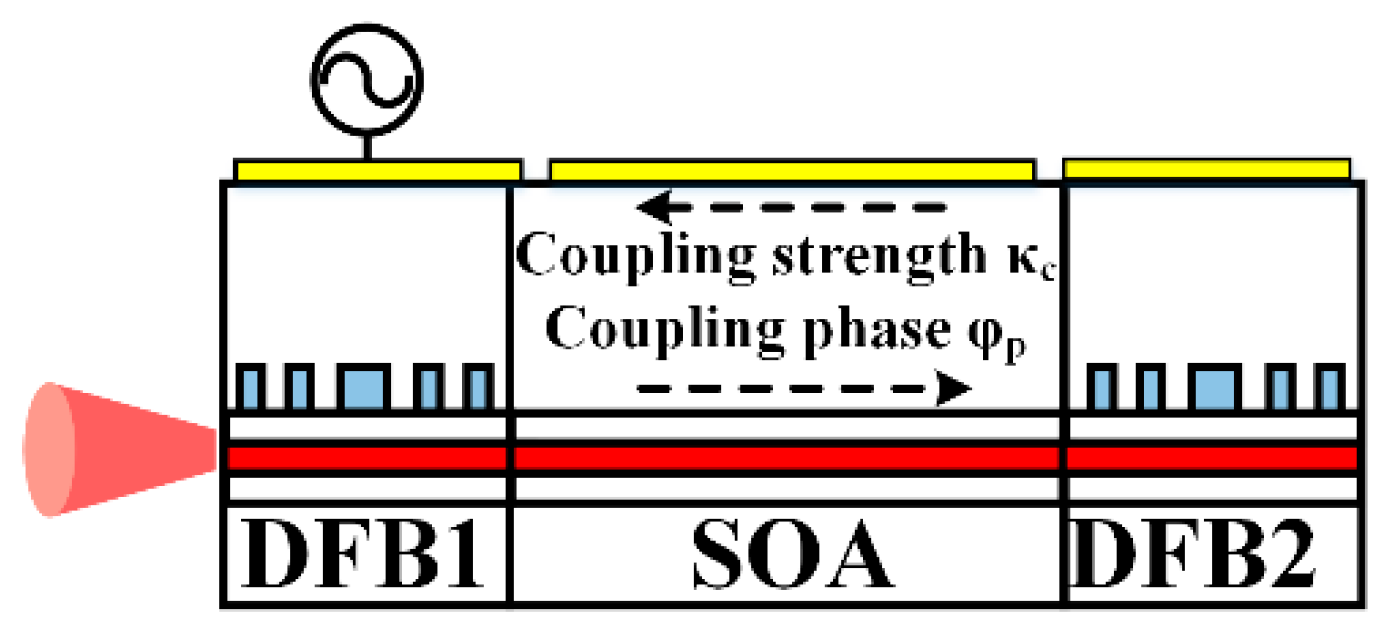

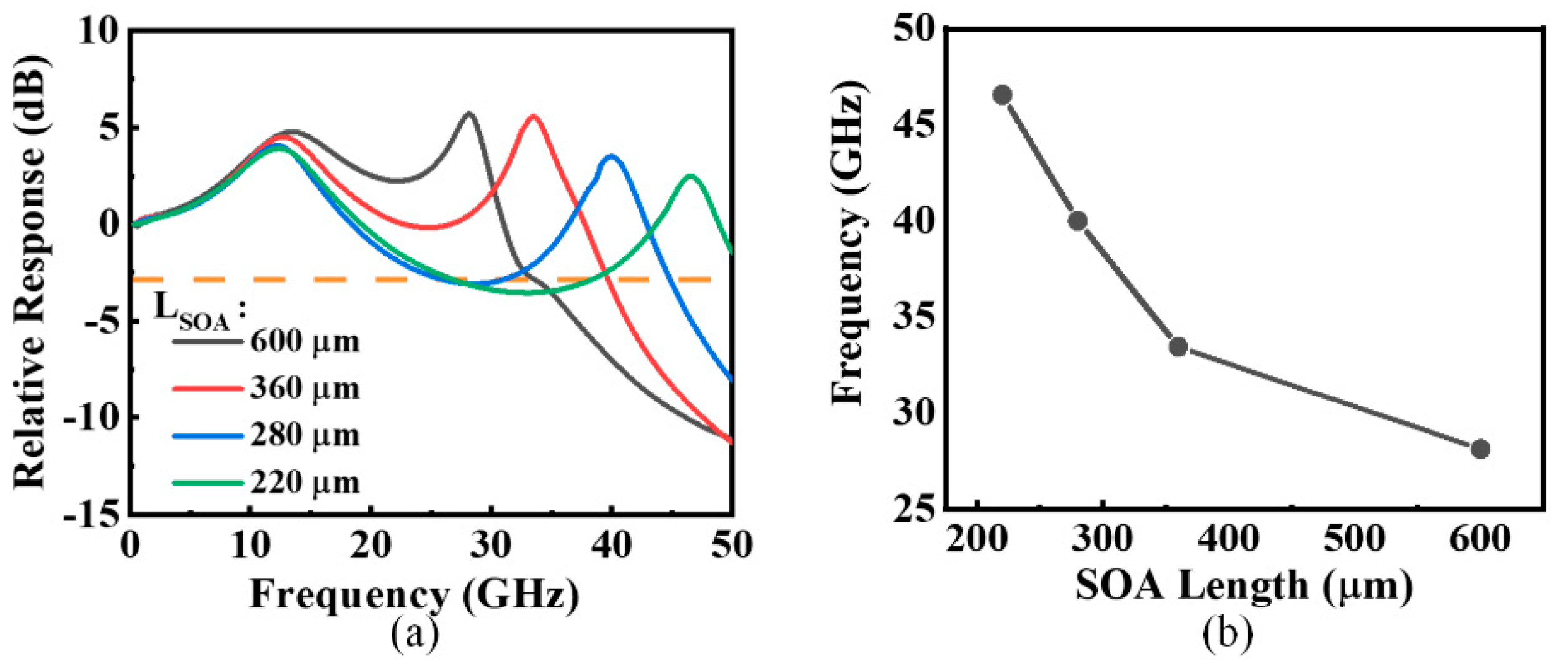
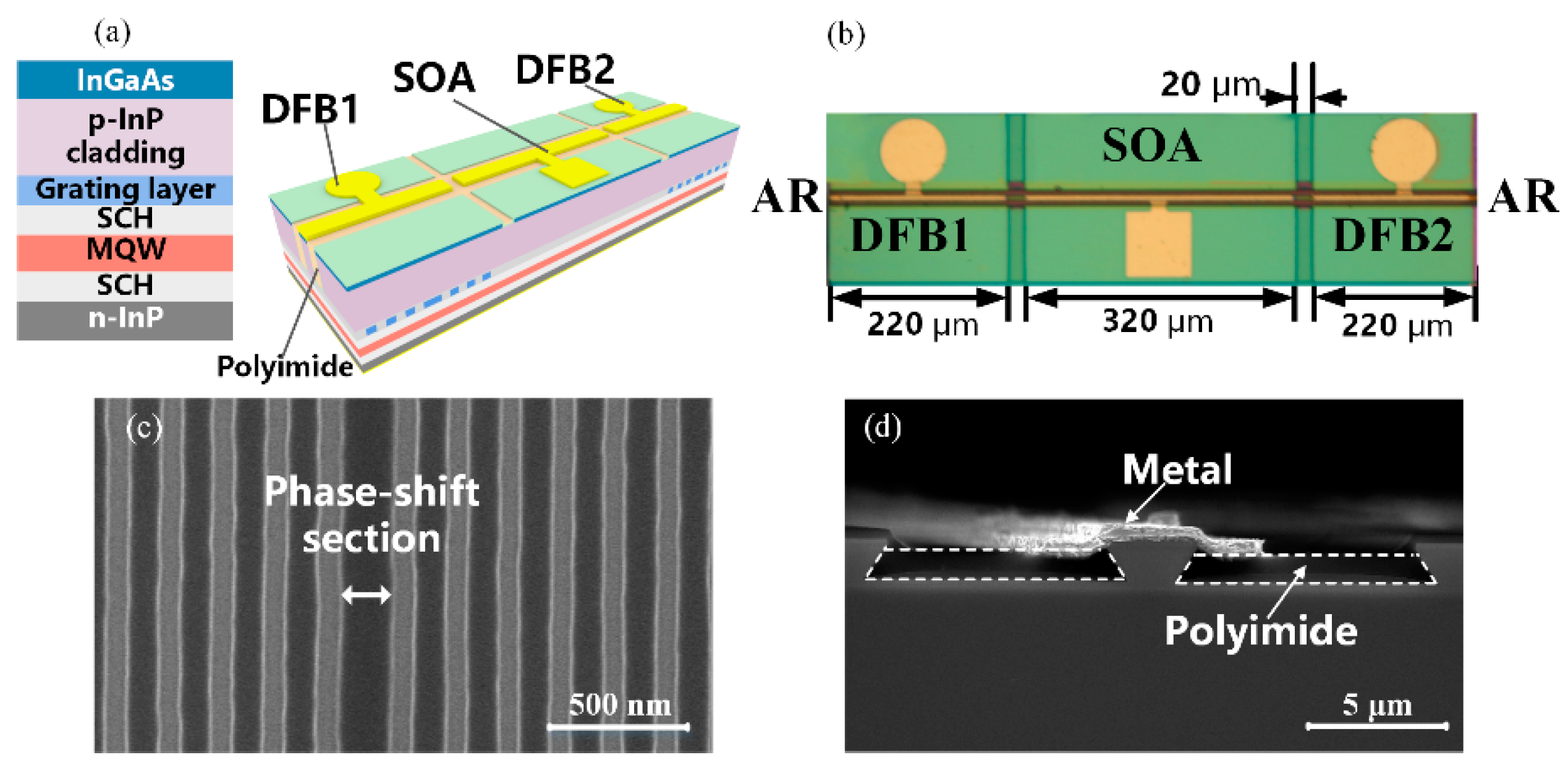
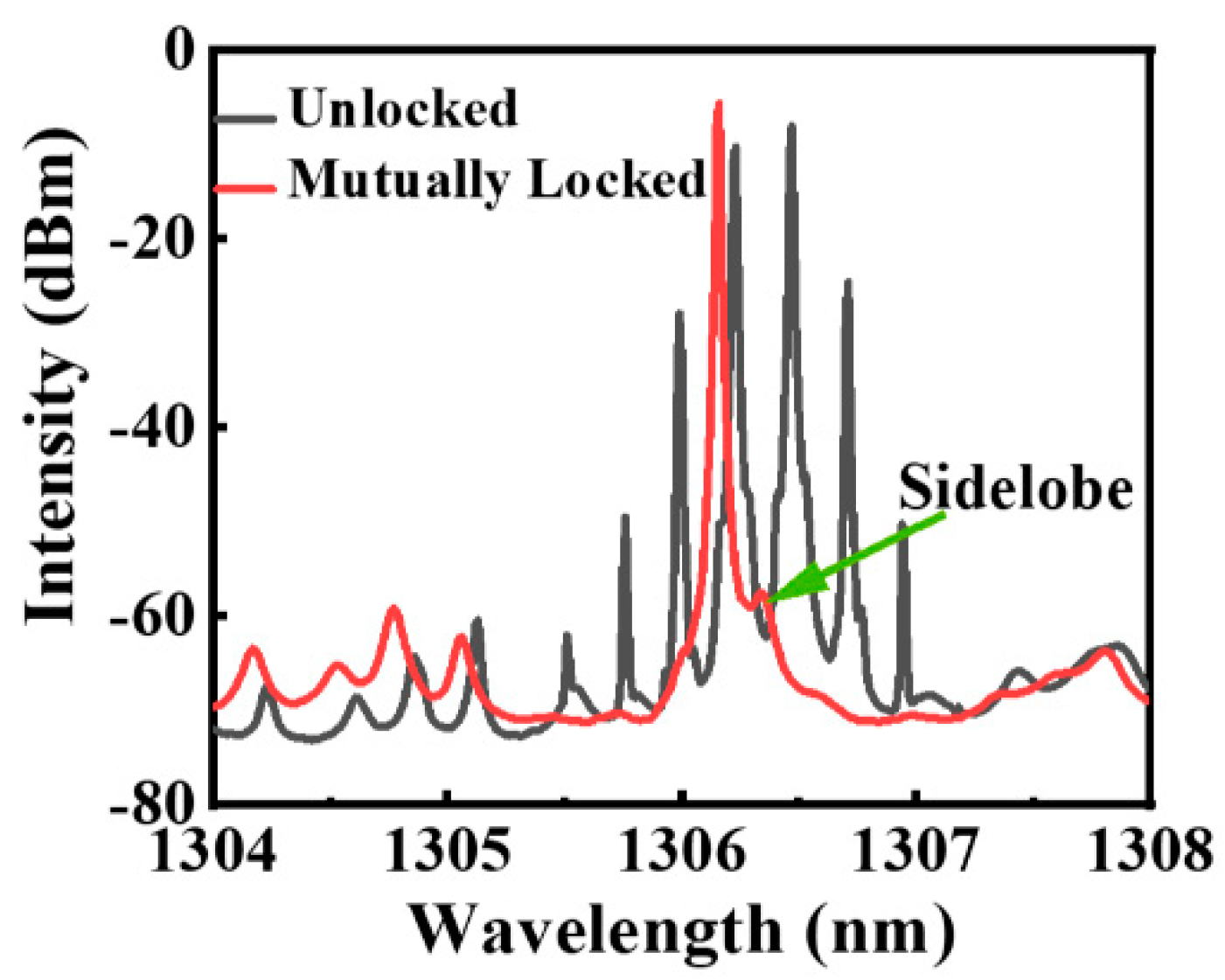
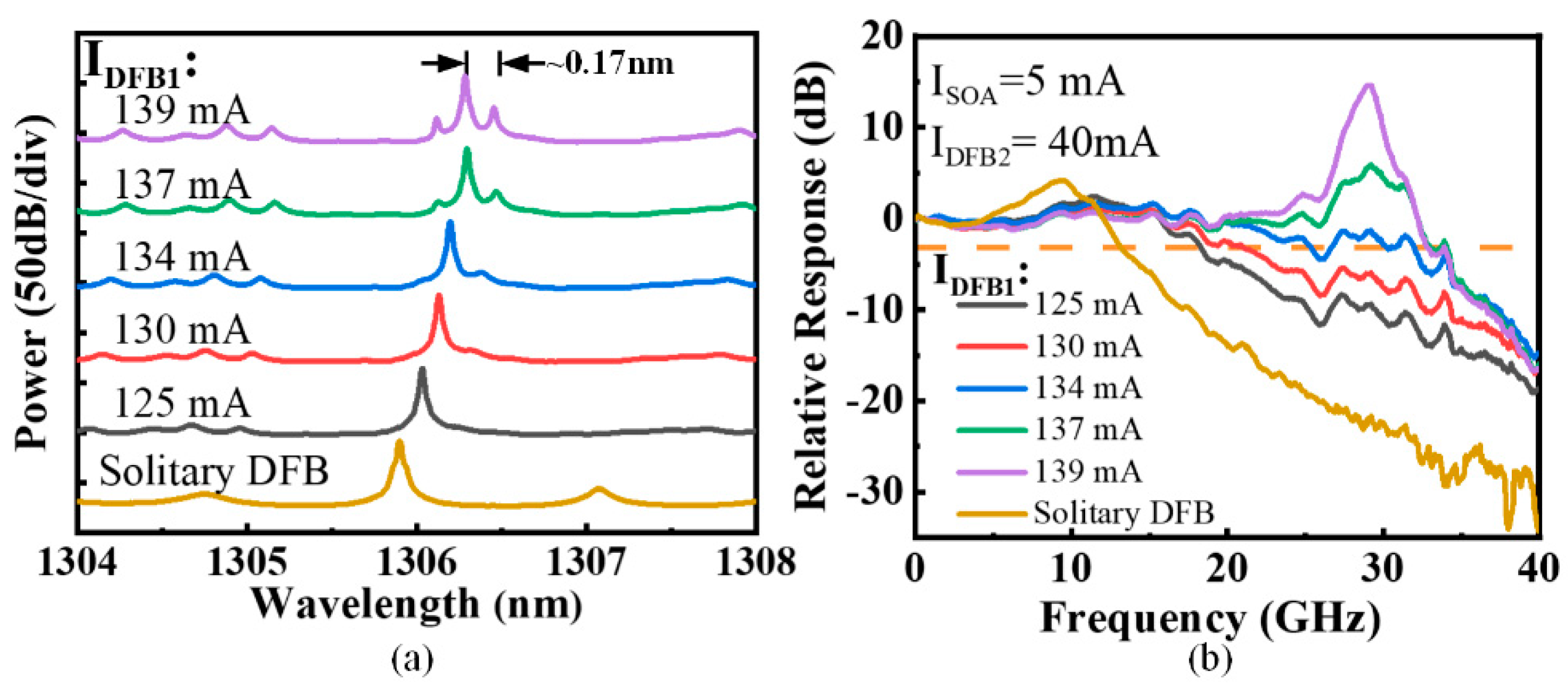
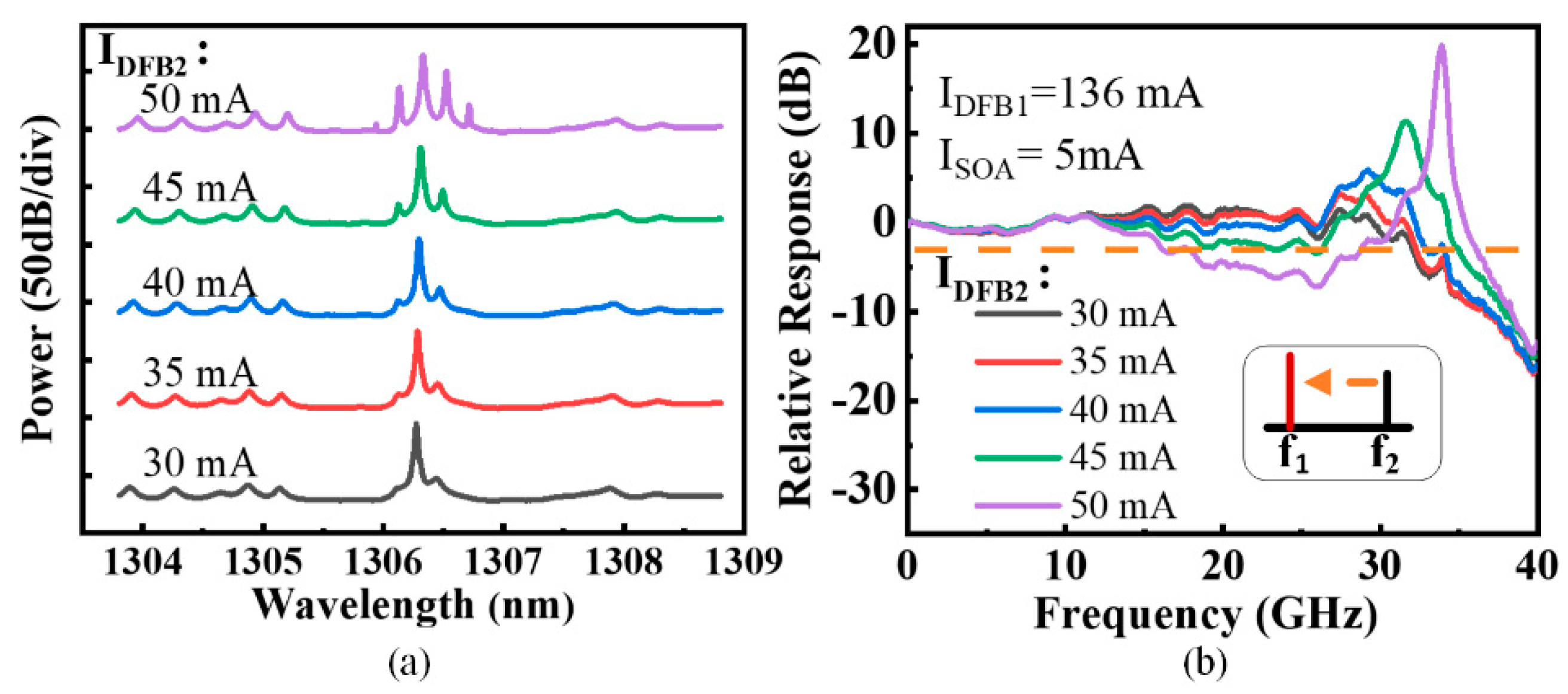




| Reference | Type of Laser | fR 1 or f3dB 2 | Bit Rate |
|---|---|---|---|
| [19] | Monolithic injection-locked DFB lasers | fR: 23 GHz | - |
| [21] | Monolithically integrated coupled-cavity DBR lasers | fR: 30 GHz | - |
| [23] | Integrated two-section discrete mode laser | f3dB: 10 GHz | - |
| [24] | Monolithically integrated DFB lasers | fR: 34.3 GHz | - |
| [28] | Monolithic integrated two-section DFB laser | fR: 26.8 GHz | - |
| [29] | Integrated coupled three-section DFB lasers | f3dB: 18.7 GHz | - |
| [25] | Coherently coupled 2 × 1 VCSEL arrays | f3dB: 37 GHz | 36 Gb/s |
| This work | Integrated coupled DFB lasers | f3dB: 38.7 GHz | 40 Gb/s |
| Explanation | Values | Unit |
|---|---|---|
| Nominal Wavelength (λ) | 1.31 | μm |
| DFB Section Length (LDFB) | 220 | μm |
| SOA Section Length (LSOA) | 360 | μm |
| Internal Loss (αi) | 3000 | 1/m |
| Logarithmic Gain Coefficient | 2.1 × 105 | 1/m |
| Gain Compression Factor | 1 × 10−23 | m3 |
| Transparency Carrier Coefficient (Ntr) | 1.5 × 1024 | 1/m3 |
| Linewidth Enhancement Factor (α) | 3 | - |
| Linear Recombination Coefficient (A) | 3 × 108 | 1/s |
| Bimolecular Recombination Coefficient (B) | 1 × 10−16 | m3/s |
| Auger Recombination Coefficient (C) | 1.3 × 10−41 | m6/s |
| Index Grating Coupling Coefficient (κi) | 6000 | 1/m |
| Grating Phase Shift (θ) | 90 | ° |
| Reflectivity of Facets (R) | 0.1% | - |
© 2020 by the authors. Licensee MDPI, Basel, Switzerland. This article is an open access article distributed under the terms and conditions of the Creative Commons Attribution (CC BY) license (http://creativecommons.org/licenses/by/4.0/).
Share and Cite
Zhao, W.; Mao, Y.; Lu, D.; Huang, Y.; Zhao, L.; Kan, Q.; Wang, W. Modulation Bandwidth Enhancement of Monolithically Integrated Mutually Coupled Distributed Feedback Laser. Appl. Sci. 2020, 10, 4375. https://doi.org/10.3390/app10124375
Zhao W, Mao Y, Lu D, Huang Y, Zhao L, Kan Q, Wang W. Modulation Bandwidth Enhancement of Monolithically Integrated Mutually Coupled Distributed Feedback Laser. Applied Sciences. 2020; 10(12):4375. https://doi.org/10.3390/app10124375
Chicago/Turabian StyleZhao, Wu, Yuanfeng Mao, Dan Lu, Yongguang Huang, Lingjuan Zhao, Qiang Kan, and Wei Wang. 2020. "Modulation Bandwidth Enhancement of Monolithically Integrated Mutually Coupled Distributed Feedback Laser" Applied Sciences 10, no. 12: 4375. https://doi.org/10.3390/app10124375





